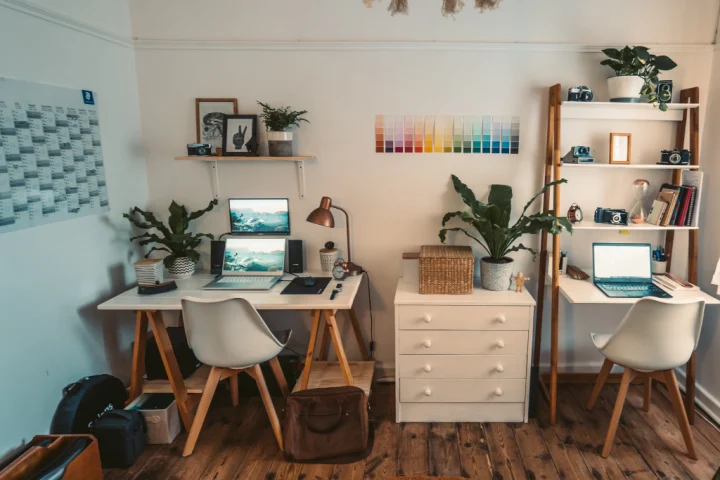Whether your home office is an entire room or just a corner of the bedroom, you can get more done by organizing supplies and files. Clever storage solutions like drawers, cabinets, and open shelves make it easy to keep work items separate from household items.
Use a mail station to organize incoming and outgoing mail, and create an inbox and outbox for your family members’ assignments, bills, and correspondence.
Create a Mail Station
Whether your home office is an entire room, a desk in the entryway, or a nook in a bedroom, designate an area for sorting mail and paper clutter. Stock this station with a wastebasket, calendar, and shredder to eliminate paper clutter before it gets out of hand.
A stacked set of woven baskets or bins can organize incoming and outgoing mail, notes, and papers. Label each basket or container to identify its function and create a filing system for your lifestyle and home office needs.
For outgoing mail that requires stamps and shipping labels, create a designated spot to prep this type of correspondence. Ensure you have a container for storing extra labels and envelopes. A simple centralized location for processing paper clutter will help you avoid missing essential notices and eliminate the need to rework or reprint documents. Color-coding your home office can also be an effective organizing tool that will help you distinguish between work and household tasks, making it easier to maintain an efficient workspace.
Create a Space for Your Printer
Home offices have become commonplace for working full-time from home, side hustles, or hobbies. While they can be a great way to get work done in a more relaxing environment than a bustling coffee shop or the library, they can quickly become cluttered and unproductive. Practical storage Hampton NJ solutions help tame office clutter and create a functional space that is relaxing and productive.
To hide your printer in a home office so that it doesn’t detract from the sleek look of the room, try incorporating it into a bookcase with plenty of open storage spaces. This allows you to store books, decor, and other items without compromising the functionality of the office and can keep your papers, documents, and supplies organized and accessible.
If you want more visible storage options, consider converting your home office into a mudroom-style command center with cork tiles and lots of open shelving. This will give you easy access to necessary paperwork and bills, preventing them from piling up on your desk or getting lost in a messy drawer.
Create a Space for Your Supplies
One of the keys to keeping a home office organized is creating a defined space for supplies and documents. Whether you invest in a caddy or a rolling cart, holding a space for your most-used items keeps your desk clear and helps prevent them from spreading to other areas of your workspace.
Using the same method used in mudrooms and kitchen family command centers, clustering your most-used items in a specific area keeps them within reach. It eliminates clutter from other areas of your home office. A small table and a few well-chosen storage pieces can simplify this task.
Aside from storing your supplies in a designated space, limiting what you keep on your desk can also help with productivity. If you don’t need a paper copy of something, consider scanning it and saving it digitally. Throwing out or shredding junk mail and filing incoming paperwork as soon as it arrives is another good habit to develop, along with regular weekly cleaning of the desk.
Create a Space for Your Books
Nothing stifles productivity like a messy home office. Stacks of papers, random cords, and coffee mugs from who knows when can create an overwhelming mess that hinders rather than promotes creativity. After thoroughly decluttering, bring your order back to your workspace with practical home office storage solutions.
Whether you need extra desk space or a place to keep your books, a freestanding bookshelf can offer both. For a customized solution, consider a built-in bookcase that blends seamlessly with the rest of your room or, for a more budget-friendly option, add a trough-style cabinet, as seen here from The Layered House.
Like any organized space, a home office needs a daily practice of tidiness. Establish a system for mail and paper clutter to prevent it from building up and becoming unmanageable, such as sorting junk mail, tossing outgoing bills, and filing incoming paperwork as soon as you receive it. This simple practice will help keep your home office tidy and functional for a long time.

